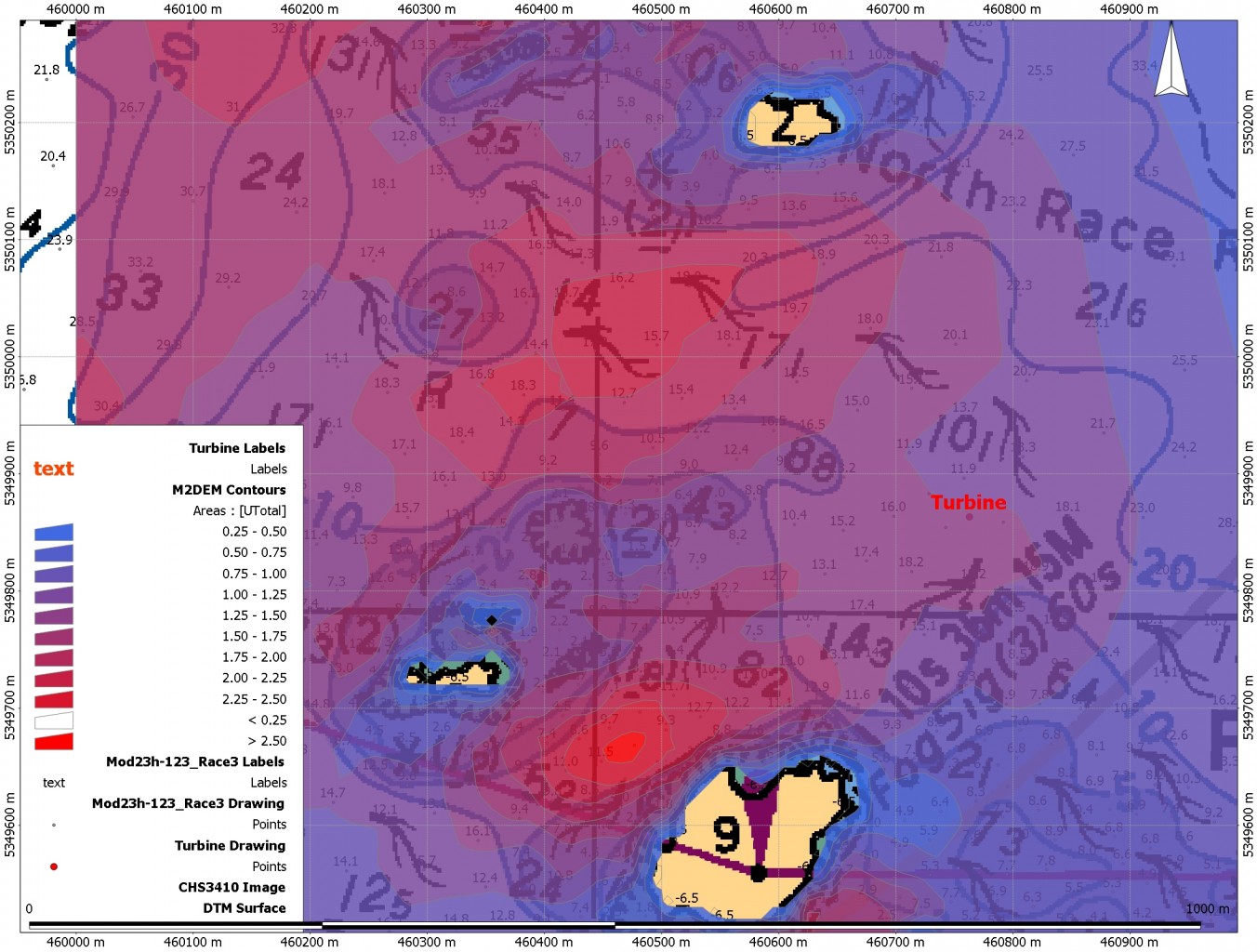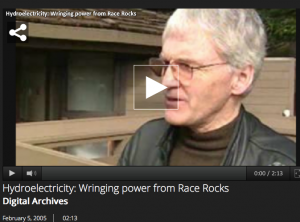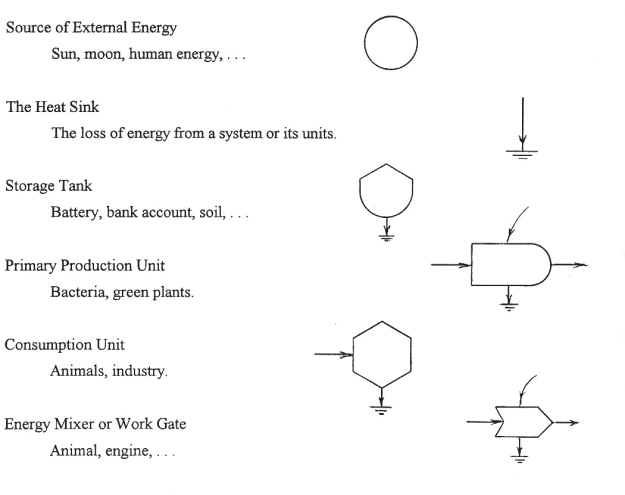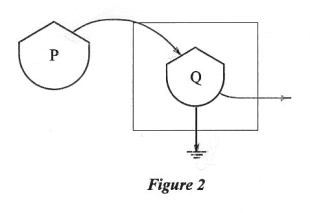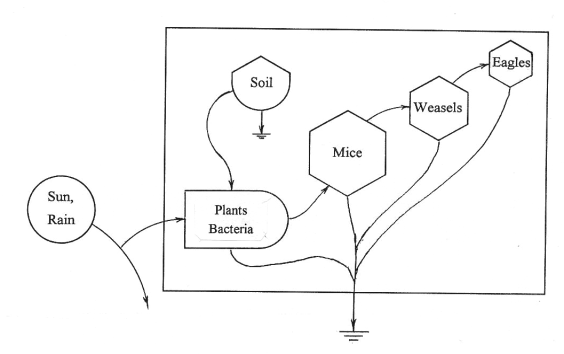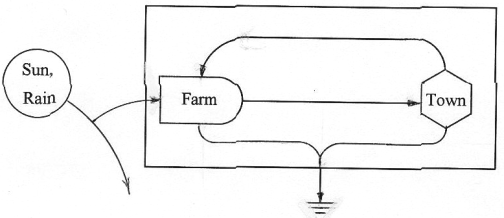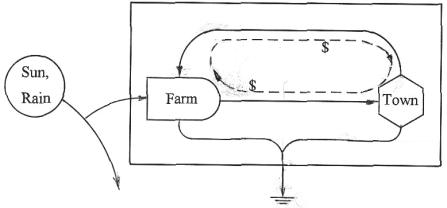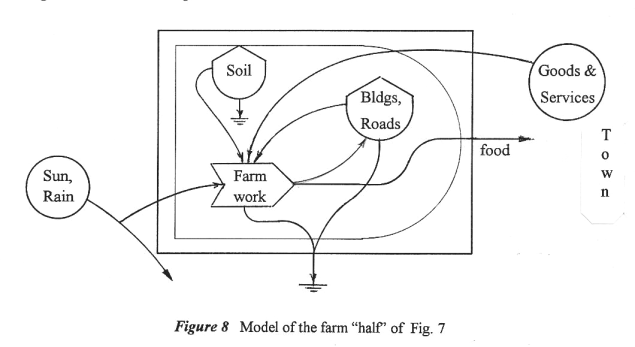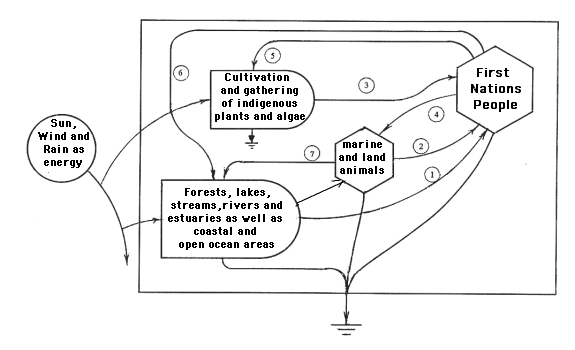Pearson College students took part in the deployment and retrieval of the ADCP instrument in several locations around Race Rocks in order to determine the optimal location for the Tidal Generator installation. This map was the result when the data was analysed:
Category Archives: Education
Air Temperature Effects on organisms at Race Rocks
The abiotic effects of air temperature
on the distribution of organisms at Race Rocks.
In this video we discuss the effects on diatom growth from the increasing temperature which results from the increasing levels of solar energy in the early spring in the upper intertidal zone on Great Race Rocks.
Tidal Energy Project -Announcement of Partnership
On February 25, 2005, Pearson College hosts the announcement of the Pearson College, ENCANA, Clean Current Tidal Power Demonstration Project at Race Rocks.
This video by Alexander Mirzoyan ( yr 31) (Russia) presents the complete proceedings and speeches. Pearson College Director Stewart Walker leads off with introductions to the speakers
Energy Diagrams based on the work of Odum
Energy Diagrams
1. Introduction Ecologist Howard T. Odum of the University of Florida created a set of symbols for the visual modeling of environmental systems. He called them energy diagrams. His symbols are very suggestive of biological processes. The first stage of our modeling consists of drawing an Odum diagram of the process, or system.
2. The Basic Diagrams The six energy symbols below suffice for most systems modeling. A complete set of the Odum symbols can be found in Odum’s publication.
These diagrams allow us to do qualitative modeling. Later, they maybe able to assist you in quantitative modeling. The lines denote energy pathways.
3. External Energy Source When the circle represents a renewable source such as sunlight, tidal flow, or a stream, it appears on the left. As the this energy flows by some of it is absorbed or pumped in by the system — the rest flows on by. When the circle represents human goods or services or products, it appears on the right.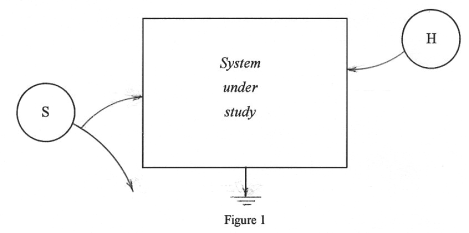
4. The Heat Sink The term “heat sink ” comes from thermodynamics. In engineering, energy loss is usually thermal in nature. However, we recognize many other kinds of losses such as disease, noise and pilfering.
The heat sink symbol – without the arrow – comes from electrical engineering and denotes a ground. Electricity can flow in and out of a ground, but energy losses do not flow in and out of a heat sink. Once degraded energy goes into the sink, it does not return. The heat generated by your body when you exercise does not flow back into your body after it has left it and water in a bathtub that has cooled does not re-heat itself. The arrow suggests a one-way trip.
All real systems leak. Therefore, every system will have a heat sink attached, as in Figure 1. The paths to the sink will carry energy from various system processes or sources, so the heat sink represents generic energy loss.
5. Tanks As for systems, so for tanks within the system — they all leak. Tanks can have many energy pathways but one outgoing path will always go to the sink. Energy flow to the sink (and through all passive outgoing paths) is proportional to the quantity of energy stored. The box displays three specific examples of stored energy and how it can be lost.
|
Notice the general use of the term energy, far beyond the force x distance definition. We go beyond physical energy and the “Goods & Services” of economics. We also include the goods and services provided by nature, the Ecosystem Services. This is a topic we can pursue in another part of the OceanQuest Project. Among such goods, or natural products are oil, water, and salt. Among the services are the cleansing of waste water, the oxygen provided by rain forests, and the “buffering” of carbon dioxide by the oceans. In addition, we include the energy “embodied” in structure and information.
It is possible in more advanced studies to show a quantitative relation among money, time and energy , This is qualitatively apparent since money readily trades for energy in its various forms such as food, gasoline, and electricity. The relation is established by the truism “Time is money”
6. Primary Production Chemosynthetic bacteria, Photosynthetic cyanobacteria bacteria, green plants and algae are the primary producers. They can transform chemical molecules such as carbon, hydrogen and oxygen into glucose and other biologically useful compounds. This basic process is known as chemosynthesis in thefirst group of bacteria and photosynthesis in green plants,algae and cyanobacteria. The production diagram will also be used for larger systems such as farms or ponds powered by the two primary producers. It might occasionally be used in a metaphorical sense to represent manufacturing. Production units will always have at least one back input and at least one top input.
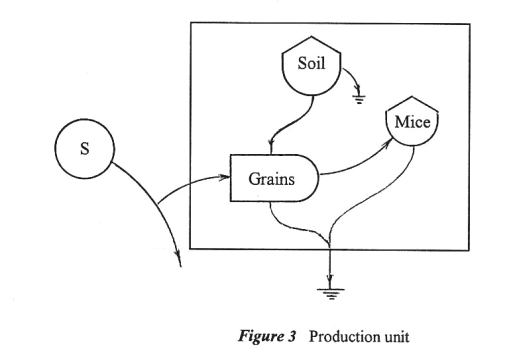 |
7. Consumption Units The remaining three biological kingdoms are the consumers – animals, fungi, and protochitsta, . The consumer diagram may also be used to represent cities, factories and bureaucracies. Consumers are classified by biologists as: Primary – bees, carp, mice Secondary – hornets, bass, weasels Tertiary – spiders, alligators, eagles. Below is a diagram with examples of all three types of consumers.
Figure 4 Consumer units — a food chain
8. Modeling A farm and a town interact in several ways. The farm produces food, sends it to the town and receives money in return. The town supples goods, such as chemicals or tools, and services in the form of labor and receives money in return. The first model of this situation might be fairly concrete, a pictorial one, as in Fig. 5. Notice that the energy paths are denote by solid lines, and the money paths by dashed lines.

|
Figure 5 Pictorial model of farm-town interaction
The next step is to replace the picture elements with an Odum diagram:
|
Figure 6 Model of farm-town interaction
|
Now add the currency or money pathway. This path tracks the energy path but moves in a counter direction:
Energy is a part of the natural world, while currency is a part of the design world – a human construct. Currency represents energy but it is just an IOU in a standard, convenient form. Most countries have no hard cash thing to back up their paper money. The potency of paper money resides in the faith that users have in the country that issues it. Energy, on the other hand, does not depend on the opinion of the user or the vote of politicians. The dashed currency line should remind us of this precarious nature of currency, as opposed to the solid flow of energy.
9. Energy Mixer or Workgate This unit allows energies of different “qualities” to interact. The Farm-Town model provides a good example of how a work gate operates. The below diagram looks inside the production unit of the farm. Higher quality energy goes
in the top of the work gate, lower quality in the back. “Higher quality” can be taken to mean more expensive, more concentrated, or less abundant. All losses should have paths leading to the system sink. Sometimes “local” sinks are drawn to avoid a spaghetti entanglement of paths. These are just visual shortcuts – the system has only one sink. Note the explicit feedback from the stored energy in buildings & roads to the work gate. This is a “reward” for the farm work that maintains these important facilities. A work gate or production unit that contributes to a storage or a consumer can expect a feedback reward.
Exercise 5.1 Use your template to re-draw the diagram in Fig. 8. Add a currency path to the system diagram. It will be an open loop, going in and out of the system.
Exercise 5.2 Draw a matching diagram for the town “half”. To keep it simple, assume that the town is mainly dependent on one industry such as a canning or food-packing plant.
10. Pre-Columbus Culture There were approximately 600 First Nations tribes in what is now Canada and the USA. The Odum diagram below models a typical First Nation people living self-sufficiently on renewable energy.
|
Figure 9 North American First Nations People living self-sufficiently
|
Note that no currency paths are needed for this system. Some First Nations People did have currency or wampum, beads made from mollusk shells, and a variety of tools, clothing and decorative items used as Potlatch or trading items.
Exercise 1 Suggest some items that flow through paths 1 and 2.
Exercise 2 How would the items that flow through along paths 1 and 3 differ? Can you name three items of great food and cultural importance that flowed through path 3?
Exercise 3 Explain feedback path 5.
Exercise 4 Explain feedback paths 6 and 7.
Exercise 5 Explain feedback path 4.
This reference is based on the work of:
http://web.math.fsu.edu/%7efusaro/DL/index.html#toc5
References for further study:
Energy, Ecology, & Economics. by Howard T. Odum http://www.mnforsustain.org/energy_ecology_economics_odum_ht_1973.htm
Emergy Evaluation by Howard T. Odum
http://www.mnforsustain.org/emergy_odum_howard_t_emergy_evaluation.htm
Attribute to Eugene P.Odum
http://www.researchmagazine.uga.edu/summer2002/odum.htm
racerocks.com Wins Prestigious Educational Award
|
Originally published in the Pearson College Newsletter, THE LINK September 17, 2004. Link no.66. No one who knows Garry Fletcher — and that includes almost every graduate of Pearson College — can doubt his passion for the environment. No one who has followed the development of the racerocks.com (now.ca) website, connecting the world with the marine protected area just beyond Pearson College, will be surprised that it was singled out in July for an award of excellence from the Commonwealth of Learning. The award recognizes the immense contribution of the website to non-formal distance learning. “It was an opportunity to share our good fortune with the wider educational community,” Garry has commented on the way he has beamed the rich ecosystems of Race Rocks outward electronically to museums, schools, and all individuals interested in a close look at marine life. From anywhere in the web world it is possible to watch the sealions bask and swim, to see the interaction of abundant species, and to see divers below the surface interacting with requests from children far away. “Through technology we can introduce visitors to marine ecology – without the real visits that would damage a sensitive site.” The web site racerocks.com was chosen for the following reasons by the jury: • it is fitting for a variety of clientele needs in non-formal education in the very important area of the environment • it has adopted a sound learning and instructional design, and • it uses a variety of media which can be integrated in a flexible manner according to individual learning needs and interests Garry Fletcher retired from Pearson College this summer after some thirty years of teaching Biology and Environmental Systems. He has not, however, gone far: he lives just down the road, and continues to pass through the college on the way to Race Rocks, the marine area for which he has been instrumental in gaining protected status, and for whose website he has just been highly honoured. |
http://web.archive.org/web/20041221184308/http://peernet.lbpc.ca/thelink/091704/06racerck.html
Eileen Dombrowski
September 17, 2004. Link no.66
Commonwealth Of Learning Announces 2004 Award winners.
EXCELLENCE IN DISTANCE EDUCATION AWARDS
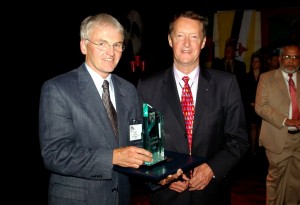 Garry Fletcher receives an award from Sir John Daniel * for the website “racerocks.com” on behalf of Lester B. Pearson College. A Gala Awards banquet was held to announce the 2004 recipients of the Excellence in Distance Education Awards (EDEA).
Garry Fletcher receives an award from Sir John Daniel * for the website “racerocks.com” on behalf of Lester B. Pearson College. A Gala Awards banquet was held to announce the 2004 recipients of the Excellence in Distance Education Awards (EDEA).
*(Sir John Daniel – President of the Commonwealth of Learning) Further information: http://www.col.org/edea
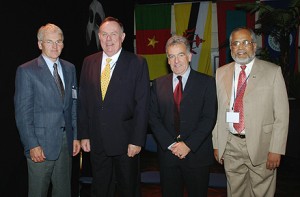 The third EDEA were conferred at the third Pan-Commonwealth Forum on Open Learning in Dunedin New Zealand, 6 JULY 2004: The photo shows- left to right: Garry Fletcher, for Category B. Dr. Thomas Webster (U. of Papua New Guinea) and Chris Baker (the Open University, Gt Britain) for category A, and Prof Mohan Menon ( Chair of Selection Committee)
The third EDEA were conferred at the third Pan-Commonwealth Forum on Open Learning in Dunedin New Zealand, 6 JULY 2004: The photo shows- left to right: Garry Fletcher, for Category B. Dr. Thomas Webster (U. of Papua New Guinea) and Chris Baker (the Open University, Gt Britain) for category A, and Prof Mohan Menon ( Chair of Selection Committee)
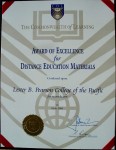 |
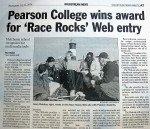 |
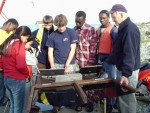 |
| The Diploma for the Excellence in Distance Education Award | Coverage of COL Award in Goldstream Gazette | Race Rocks as an example of Distance Education and Environmental Stewardship |
FROM THE “2004 CITATIONS”
COL award for excellence in distance education materials under category B: multimedia materials supporting non-formal education is awarded to Lester B. Pearson College, Victoria, Canada for its on-line materials “Racerocks.com”. We recommend this multi-media material for the award because:
it is fitting for a variety of clientele needs in non-formal education in the very important area of the environment
it has adopted a sound learning and instructional design, and
it uses a variety of media which can be integrated in a flexible manner according to individual learning needs and interests
An attractive, well-laid out site with a plethora of resources including quality content and activities providing a virtual tour of the ecosystem without actually being there. The website provides a variety of activities and resources for students and teachers at different levels, especially those in middle and high schools. The site has been designed to provide images to those who have slow computer and/or network connections thereby increasing the accessibility to the site. It enables learners to interact with a sensitive environmental area without affecting it. The nature of materials and their presentation is such that learners may either be guided to work through the site in a systematic or structured manner or they can proceed randomly, yet still learn something. It includes both current and archived material. Students are able to leave behind information for others to use and can take ownership of their learning. The topic covered by the site is and will continue to be of interest to a wide variety of people who want to learn about aquatic life and the environment.
Mr. President I ask you to confer the excellence in distance education materials award on the Lester B. Pearson College of the Pacific, British Columbia, Canada. Mr. Garry Fletcher will accept the award on behalf of the College.
Speaker: Dr. Mohan Menon
> Commonwealth of Learning (COL)
> Suite 600 – 1285 West Broadway, Vancouver, BC V6H 3X8 CANADA
> COL is an intergovernmental organisation created by Commonwealth Heads of Government to encourage the development and sharing of open learning and distance education knowledge, resources and technologies.
California Sea cucumber reproduction
This California Sea Cucumber male was emitting sperm while in the tank at Race Rocks in early June, 2004 . This went on for several hours. Millions of sperm are broadcast into the water where they may have a chance encounter with eggs, also released into the current by the females. Of the great numbers of eggs and sperm released only a few are fertilized and actually make it to maturity. This is a good example of
r-selection in the population.
Journey Middle School Class(2) visits Race Rocks
On Wednesday 2 June 2004, the grade six students of Journey Middle School in Sooke visited the island and were given an explanation of how the island is maintained. They visited the marine science centre student residence and also ventured into the engine room. They were welcomed by students from Pearson College, Emmanuel, Paul and Michelle, who were staying on the Island for 2 weeks doing the Johann Ashuvud project. While there they participated in a live webcast.
Johan Ashuvud Project at Race Rocks -2004
During the Johan Ashuvud project 2004, students explored the intertidal with Garry Fletcher. They examined various organisms as well as the artificial tidepool. In this video, we also get a chance to meet all the students taking part in the project.
A school visit by Journey middle school students
The Johan Ashuvud Project June 2004
On 1st June 2004, during the Johan Ashuvud project, we had Dr Gitai Yahel and Russel Wyeth explain to the students and faculty from Journey Middle School in Sooke their research at Race Rocks . This was during a live webcast by Emmanuel (PC 30) from Ghana and Paul (PC 30) from Nigeria. Later we showed the students various living organisms in the tank room and gave the students a tour of the island.
